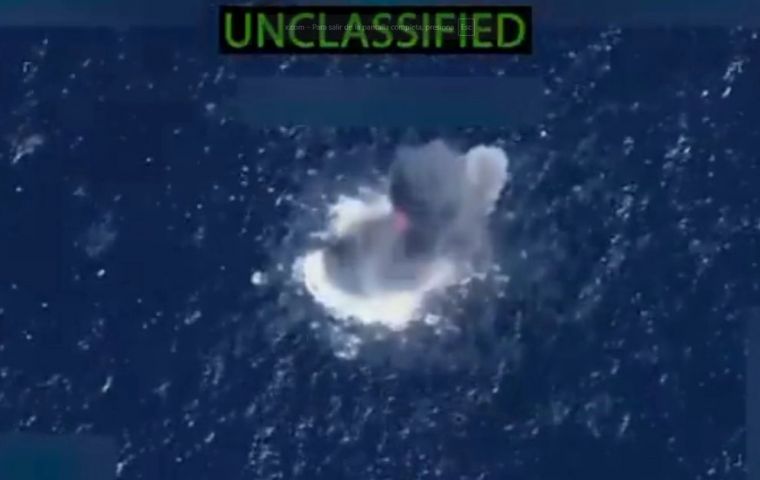MercoPress. South Atlantic News Agency
New US attacks leave 14 dead in Pacific Ocean
 These latest assaults bring the total number of maritime airstrikes to 13 and the death toll to at least 57
These latest assaults bring the total number of maritime airstrikes to 13 and the death toll to at least 57 The Pentagon announced on Tuesday it executed three new strikes against alleged drug-smuggling vessels in the eastern Pacific Ocean, killing 14 people in the deadliest single wave of attacks so far in President Donald Trump's intensified military campaign against illegal narcotics.
Secretary of War Pete Hegseth confirmed that four boats were targeted on Monday in international waters, with only one individual surviving the assaults. No US service members were injured.
Yesterday, at the direction of President Trump, the Department of War carried out three lethal kinetic strikes on four vessels operated by Designated Terrorist Organizations (DTO) trafficking narcotics in the Eastern Pacific.
— Secretary of War Pete Hegseth (@SecWar) October 28, 2025
The four vessels were known by our intelligence… pic.twitter.com/UhoFlZ3jPG
In a post on X that included video footage of the strikes, Hegseth justified the action by equating drug traffickers with international terror groups: “The Department has spent over TWO DECADES defending other homelands. Now, we’re defending our own. These narco-terrorists have killed more Americans than Al-Qaeda, and they will be treated the same. We will track them, we will network them, and then, we will hunt and kill them,” he wrote.
These latest assaults bring the total number of maritime airstrikes to 13 and the death toll to at least 57 since the military campaign began. While most attacks have occurred in the Caribbean, the Department of War first expanded its operations to the Pacific Ocean, west of Central America, on October 21 and 22.
The escalation has drawn sharp criticism from Democrats in Congress, who question the legality of using lethal military force against targets that do not pose an immediate threat to the United States.
Lawmakers have not yet received evidence from the Trump administration to support claims that the targeted boats were carrying narcotics. Democrats are demanding information regarding the identities of those killed and the intelligence used to justify the strikes.
Administration officials argue that President Trump’s designation of certain drug cartels as “foreign terrorist organizations” earlier this year provides the legal justification for the ongoing military campaign.
The maritime campaign coincides with a massive build-up of US military assets in the Caribbean, intensifying speculation about a potential military action against Venezuela. Trump has repeatedly blamed Venezuelan cartels and President Nicolás Maduro for the flow of drugs into the US and recently stated he was considering land targets in the country.
The US Navy currently has at least eight ships in the region, including guided missile destroyers and a missile cruiser capable of launching Tomahawk missiles deep into Venezuelan territory. Deployed forces include thousands of troops embarked on ships, complete with landing craft and Osprey aircraft for potential land operations, land-based Marine Corps F-35 fighter jets are operating from Puerto Rico, while Air Force heavy bombers are repeatedly conducting shows of force near the Venezuelan coast. Hegseth recently ordered the deployment of the USS Gerald R. Ford aircraft carrier—the largest warship globally—to the South American coast, along with three additional guided missile destroyers.
The Ford, which carries multiple squadrons of F/A-18 attack fighter jets and electronic warfare aircraft, is capable of a significant aerial bombing campaign and is expected to arrive in the Caribbean in early to mid-November.




Top Comments
Disclaimer & comment rulesCommenting for this story is now closed.
If you have a Facebook account, become a fan and comment on our Facebook Page!